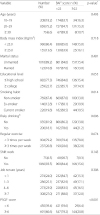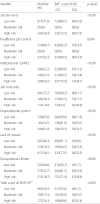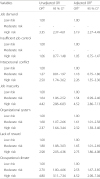4. Kessler RC, Berglund P, Demler O, Jin R, Merikangas KR, Walters EE. Lifetime prevalence and age-of-onset distributions of DSM-IV disorders in the National Comorbidity Survey Replication. Arch Gen Psychiatry. 2005; 62(6):593–602. DOI:
10.1001/archpsyc.62.6.593. PMID:
15939837.
5. Wittchen HU, Jacobi F, Rehm J, Gustavsson A, Svensson M, Jönsson B, et al. The size and burden of mental disorders and other disorders of the brain in Europe 2010. Eur Neuropsychopharmacol. 2011; 21:655–679. DOI:
10.1016/j.euroneuro.2011.07.018. PMID:
21896369.
6. Demyttenaere K, Bruffaerts R; WHO World Mental Health Survey Consortium. Prevalence, severity, and unmet need for treatment of mental disorders in the World Health Organization World Mental Health Surveys. JAMA. 2004; 291(21):2581–2590. DOI:
10.1001/jama.291.21.2581. PMID:
15173149.
7. Cho MJ. The 2011 Epidemiological Survey of Mental Disorders among Korean Adults. 2011. Korean: Korean Ministry of Health and Welfare.
8. Sareen J, Cox BJ, Afifi TO, de Graaf R, Asmundson GJ, ten Have M, et al. Anxiety disorders and risk for suicidal ideation and suicide attempts: a population-based longitudinal study of adults. Arch Gen Psychiatry. 2005; 62(11):1249–1257. DOI:
10.1001/archpsyc.62.11.1249. PMID:
16275812.
9. Bolton JM, Cox BJ, Afifi TO, Enns MW, Bienvenu OJ, Sareen J. Anxiety disorders and risk for suicide attempts: findings from the Baltimore Epidemiologic Catchment area follow‐up study. Depress Anxiety. 2008; 25(6):477–481. DOI:
10.1002/da.20314. PMID:
17541978.
10. Kanwar A, Malik S, Prokop LJ, Sim LA, Feldstein D, Wang Z, et al. The association between anxiety disorders and suicidal behaviors: A systematic review and meta-analysis. Depress Anxiety. 2013; 30(10):917–929. PMID:
23408488.
12. Organization for Economic Cooperation and Development, OECD Indicators, OECD Publishing: Health at a Glance 2013; P35. [http://dx.doi.org/10.1787/health_glance-2013-en] Access date: November 28th, 20143.
13. Plaisier I, Beekman AT, de Graaf R, Smit JH, van Dyck R, Penninx BW. Work functioning in persons with depressive and anxiety disorders: the role of specific psychopathological characteristics. J Affect Disord. 2010; 125(1):198–206. DOI:
10.1016/j.jad.2010.01.072. PMID:
20185180.
14. Lim D, Sanderson K, Andrews G. Lost productivity among full-time workers with mental disorders. J Ment Health Policy Econ. 2000; 3(3):139–146. DOI:
10.1002/mhp.93. PMID:
11967449.
15. Marciniak M, Lage MJ, Landbloom RP, Dunayevich E, Bowman L. Medical and productivity costs of anxiety disorders: case control study. Depress Anxiety. 2004; 19(2):112–120. DOI:
10.1002/da.10131. PMID:
15022146.
16. The National Institute for Occupational Safety and Health(NIOSH), NIOSH working group: DHHS (NIOSH) Publication Number 99-101, Stress at work. [
http://www.cdc.gov/niosh/docs/99-101/] Access date: November 28th, 2014.
17. Melchior M, Caspi A, Milne BJ, Danese A, Poulton R, Moffitt TE. Work stress precipitates depression and anxiety in young, working women and men. Psychol Med. 2007; 37(08):1119–1129. DOI:
10.1017/S0033291707000414. PMID:
17407618.
18. Andrea H, Bültmann U, Beurskens AJHM, Swaen GMH, Van Schayck CP, Kant IJ. Anxiety and depression in the working population using the HAD Scale. Soc Psychiatry Psychiatr Epidemiol. 2004; 39(8):637–646. DOI:
10.1007/s00127-004-0797-6. PMID:
15300374.
19. Gao YQ, Pan BC, Sun W, Wu H, Wang JN, Wang L. Anxiety symptoms among Chinese nurses and the associated factors: a cross sectional study. BMC Psychiatry. 2012; 12(1):141. DOI:
10.1186/1471-244X-12-141. PMID:
22978466.
20. Park KC, Lee KJ, Park JB, Min KB, Lee KW. Association between Occupational Stress and Depression, Anxiety, and Stress Symptoms among White-collar Male Workers in an Automotive Company. Korean J Occup Environ Med. 2008; 20(3):215–224.
21. Sohn SI, Kim DH, Lee MY, Cho YW. The reliability and validity of the Korean version of the Pittsburgh Sleep Quality Index. Sleep Breath. 2012; 16(3):803–812. DOI:
10.1007/s11325-011-0579-9. PMID:
21901299.
22. Buysse DJ, Reynolds CF, Monk TH, Berman SR, Kupfer DJ. The Pittsburgh sleep quality index:a new instrument for psychiatric practice and research. Psychiatry Res. 1989; 28(2):193–213. DOI:
10.1016/0165-1781(89)90047-4. PMID:
2748771.
23. Chang SJ, Koh SB, Kang DM, Kim SA, Kang MG, Lee CG, et al. Developing an occupational stress scale for Korean employees. Korean J Occup Environ Med. 2005; 17(4):297–317.
24. Beck AT, Epstein N, Brown G, Steer RA. An inventory for measuring clinical anxiety: psychometric properties. J Consult Clin Psychol. 1988; 56(6):893. DOI:
10.1037/0022-006X.56.6.893. PMID:
3204199.
26. Osman A, Barrios FX, Aukes D, Osman JR. The Beck Anxiety Inventory:psychometric properties in a community population. J Psychopath Behav Assess. 1993; 15:287–297. DOI:
10.1007/BF00965034.
27. Yook SP, Kim ZS. A clinical study on the Korean version of Beck Anxiety Inventory: comparative study of patient and non-patient. Korean J Clin Psychol. 1997; 16(1):185–197.
28. Jeong YU, Park JB, Min KB, Lee C, Kil HK, Lee WW, et al. The Effects of Aircraft Noise Exposure upon Hearing Loss, Anxiety, and Depression on Subjects Residing Adjacent to a Military Airbase. Korean J Occup Environ Med. 2012; 24(1):40–51.
29. Yen CF, Lai CY, Ko CH, Liu TL, Tang TC, Wu YY, et al. The associations between suicidal ideation and attempt and anxiety symptoms and the demographic, psychological, and social moderators in Taiwanese adolescents. Arch Suicide Res. 2014; 18(1):104–116. DOI:
10.1080/13811118.2013.824826. PMID:
24354459.
30. Ryu SH. The Association among Suicidal Ideation, Anxiety Symptoms, and Quality of Life in Firefighters. Korean J Psychopharmacol. 2014; 25:29–35.
31. Korean statistical information service. Cause of Death. 2013.
32. Plaisier I, de Bruijn JG, de Graaf R, Have MT, Beekman AT, Penninx BW, et al. The contribution of working conditions and social support to the onset of depressive and anxiety disorders among male and female employees. Soc Sci Med. 2007; 64(2):401–410. DOI:
10.1016/j.socscimed.2006.09.008. PMID:
17055138.
33. Andrea H, Bültmann U, van Amelsvoort LG, Kant Y. The incidence of Anxiety and Depression among employees-the role of psychosocial work characteristics. Depress Anxiety. 2009; 26:1040–1048. DOI:
10.1002/da.20516. PMID:
19242984.
34. Magnavita N, Fileni A. Association of work-related stress with depression and anxiety in radiologists. Radiol Med. 2014; 119(5):359–366. DOI:
10.1007/s11547-013-0355-y. PMID:
24297590.
35. Åkerstedt T. Shift work and disturbed sleep/wakefulness. Occup Med. 2003; 53(2):89–94. DOI:
10.1093/occmed/kqg046.
36. Taylor DJ, Lichstein KL, Durrence HH, Reidel BW, Bush AJ. Epidemiology of insomnia, depression, and anxiety. Sleep. 2005; 28(11):1457–1464. PMID:
16335332.
37. Ohayon MM, Lemoine P. A connection between insomnia and psychiatric disorders in the French general population. L'Encéphale. 2002; 28(5 Pt 1):420–428. PMID:
12386543.
38. Breslau N, Roth T, Rosenthal L, Andreski P. Sleep disturbance and psychiatric disorders: a longitudinal epidemiological study of young adults. Biol Psychiatry. 1996; 39(6):411–418. DOI:
10.1016/0006-3223(95)00188-3. PMID:
8679786.
39. Ford DE, Kamerow DB. Epidemiologic study of sleep disturbances and psychiatric disorders: an opportunity for prevention? JAMA. 1989; 262(11):1479–1484. DOI:
10.1001/jama.1989.03430110069030. PMID:
2769898.
40. Weissman MM, Greenwald S, Niño-Murcia G, Dement WC. The morbidity of insomnia uncomplicated by psychiatric disorders. Gen Hosp Psychiatry. 1997; 19(4):245–250. DOI:
10.1016/S0163-8343(97)00056-X. PMID:
9327253.
41. O'Connell ME, Boat T, Warner KE. Preventing Mental, Emotional, and Behavioral Disorders Among Young People: Progress and Possibilities. National Academies; Press 2009. p. 530.
42. Alexander CN, Swanson GC, Rainforth MV, Carlisle TW, Todd CC, Oates RM Jr. Effects of the Transcendental Meditation program on stress reduction, health, and employee development: A prospective study in two occupational settings. Anxiety Stress Coping. 1993; 6(3):245–262. DOI:
10.1080/10615809308248383.
43. LaMontagne AD, Keegel T, Louie AM, Ostry A, Landsbergis PA. A systematic review of the job-stress intervention evaluation literature, 1990-2005. Int J Occup Environ Health. 2007; 13(3):268–280. DOI:
10.1179/oeh.2007.13.3.268. PMID:
17915541.
44. Kim SA, Suh CH, Park MH, Kim KH, Lee CK, Son BC, et al. Effectiveness of a Comprehensive Stress Management Program to Reduce Work-Related Stress in a Medium-Sized Enterprise. Annals of Occupational and Environmental Medicine. 2014; 26:4. DOI:
10.1186/2052-4374-26-4. PMID:
24524591.









 PDF
PDF Citation
Citation Print
Print


 XML Download
XML Download